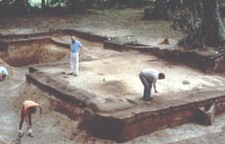Last updated: September 20, 2022
Article
Santa Elena The 1500s Capital of Spanish Florida in South Carolina

From Santa Elena, the Spanish expanded inland, building forts into the Appalachian Mountains and working to “pacify” the Native Americans through trade, violence, and conversion to Catholicism. Native Americans burned these forts, and Spain did not rebuild them. The Native Americans around Santa Elena also objected to the Spanish presence. In 1576, Native Americans from the nearby towns of Orista and Escamacu burned Santa Elena, which the Spanish rebuilt. In 1580, 2000 Native Americans again attacked the settlement, but were repelled. In 1587, the Spanish left Santa Elena, relocating to their settlement at St. Augustine, Florida to focus on colonizing other areas.
Archeology in and around Santa Elena goes back to the mid-1800s, with excavators disagreeing whether the town was French or Spanish. In 1957, National Park Service historian Albert Manucy studied the artifacts and identified them as Spanish colonial. They included pieces of pottery olive jars, plates, and other types of vessels. Later excavations (beginning in 1979) by archaeologists at the University of South Carolina, identified several structures, including a moat that surrounded Fort San Felipe, several buildings arranged around a central courtyard, a fortified house, and a Spanish pottery kiln (the only one to have been found in North America). As well as pottery pieces, artifacts found include food remains (shells from oyster, clams, and conch; pig bones, fish bones, egg shells, and seeds from watermelon, squash, and hickory nuts), building materials, items representing clothing (tips of laces called aglets, buttons, buckles, and hooks), weapon parts from crossbows, swords, pikes, and artillery, and other objects including an intact wooden barrel, thimbles, fish hooks, dice, and straight pins.
Santa Elena is the earliest known and surviving example of planned urban occupation in the United States. But, there is no map of Santa Elena made during the time of its Spanish occupation. Archeologists used maps of planned communities founded in Spain at the same time as Santa Elena to help them understand the town. Excavations reveal that the town was home to as many as 60 houses and upwards of 450 settlers and soldiers.
More About Santa Elena
- "Digging into the Colonial Past: Archeology and the 16th-Century Spanish Settlements at Charlesfort-Santa Elena" (a Teaching with Historic Places lesson plan)
- Discover Our Shared Heritage American Latino Heritage Travel Itinerary
